Chris is a gardening writer and nature enthusiast. He graduated from Oxford Brookes University in 2022 with an MA in Psychology. Chris works with the Leeds Green Action Society, helping their food cooperative by growing various fruit and vegetables on their two allotments in Hyde Park, Leeds.
Reviewed By COLIN SKELLY

Colin is a Horticulturist and Horticultural Consultant with experience in a range of practical and managerial roles across heritage, commercial and public horticulture. He holds the Royal Horticultural Society’s Master of Horticulture award and has a particular interest in horticultural ecology and naturalistic planting for habitat and climate resilience.
IN THIS GUIDE
- Choosing The Best Fast-Growing Hedges
- 1) Leylandii
- 2) Western Red Cedar
- 3) Garden Privet
- 4) Cherry Laurel
- 5) Umbrella Bamboo
- 6) Blackthorn
- 7) Common Hawthorn
- 8) Dog Rose
- 9) Common Alder
- 10) Common Hornbeam
- 11) Christmas Berry ‘Red Robin’
- 12) White Cedar ‘Smaragd’
- Why Grow A Hedge?
- Important Considerations
- Looking After Hedges
- That’s All Folks!
- References
Thanks to their shape and potential size, hedges lend themselves well to providing privacy and shelter, marking boundaries, reducing wind, and much more.
With so many types of hedging, choosing the right one for your garden comes down to your needs and preferences.
Many people want a fast-growing hedge that will quickly provide privacy or shelter.
So, if you’re wondering which hedge to choose and how long it will take to grow, you’ve come to the right place.
Choosing The Best Fast-Growing Hedges
There’s no strict definition of fast-growing, but to give a general idea, you can expect hedges to grow anywhere between 10-100cm a year.
When we speak about fast-growing hedges, we’re usually referring to hedges that grow above 40cm a year.

From examining research from different horticultural bodies, we have identified 12 trees and shrubs that can be used for hedging with a high annual growth rate in the UK.
Here is each type, ordered by their average growth in height each year:
| Tree | Average Height Increment Per Year (cm) | Maximum Height (M) |
|---|---|---|
| Leylandii | 91.5 | 30 |
| Western Red Cedar | 76.2 | 35 |
| Garden Privet | 60.0 | 8 |
| Cherry Laurel | 60.0 | 8 |
| Umbrella Bamboo | 50.0 | 4 |
| Blackthorn | 50.0 | 4 |
| Common Hawthorn | 45.7 | 8 |
| Dog Rose | 45.0 | 4 |
| Common Alder | 45.0 | 25 |
| Common Hornbeam | 40.0 | 6 |
| Christmas Berry ‘Red Robin’ | 30.0 | 4 |
| White Cedar ‘Smaragd’ | 22.8 | 3 |
Choosing to grow a hedge in a garden for privacy is, surprisingly, one of the main reasons people look to include a hedge in their garden landscaping.
Hedges are a great alternative to fencing and are perfect for when you aren’t able to erect a fence.
Below we introduce these fast-growing hedges that are good for garden privacy in more detail.
1) Leylandii
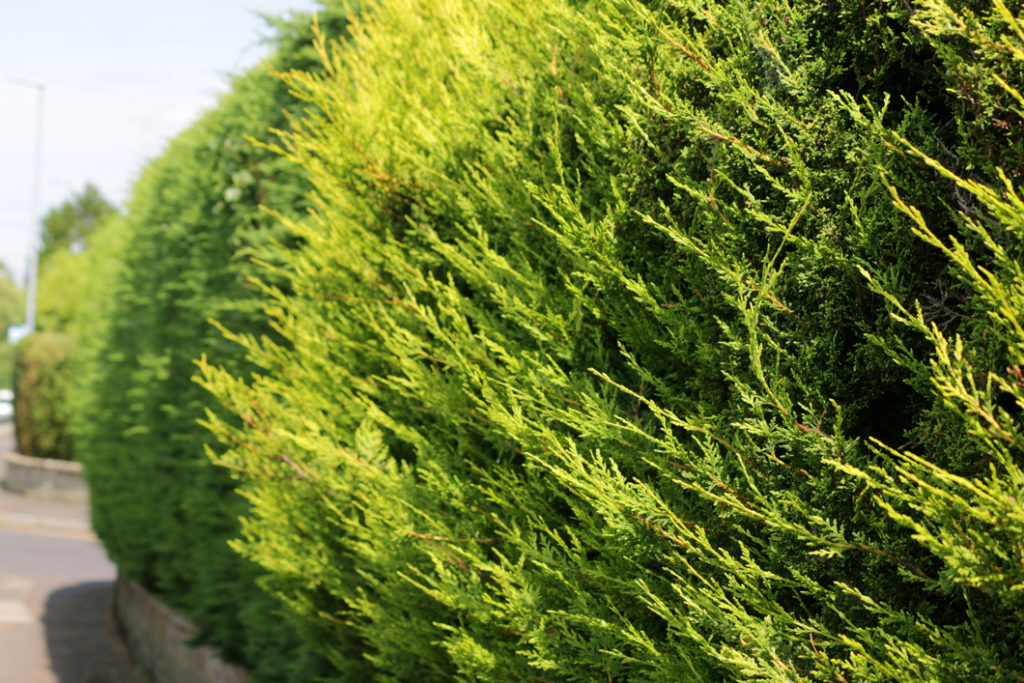
- BOTANICAL NAME: Cuprocyparis leylandii
- HARDINESS RATING: H6
- ESTIMATED ANNUAL GROWTH RATE: 91.5cm
- MAXIMUM HEIGHT: 30m
- YEARS TO EVENTUAL HEIGHT: 10-20
A frequently used hedge type is the Leyland cypress, also called Leylandii or conifer hedging.
This plant can grow a whopping 90cm per year, making it the fastest-growing hedge on our list.
This makes it a popular and cost-effective choice for gardeners.
“Cuprocyparis leylandii is certainly fast growing but so much so that it frequently causes disputes between neighbours due to the shade it casts,” shares Master Horticulturist Colin Skelly.
“It needs lots of space and regular cutting to maintain a hedge and not a sequence of tightly planted large trees.”
2) Western Red Cedar

- BOTANICAL NAME: Thuja plicata
- HARDINESS RATING: H6
- ESTIMATED ANNUAL GROWTH RATE: 76.2cm
- MAXIMUM HEIGHT: 35m
- YEARS TO EVENTUAL HEIGHT: 10-20
The Western Red Cedar is another rapidly fast-growing shrub that grows up to a huge 35m in height, making it great for garden privacy.
This evergreen shrub is not fussy and can grow in most soils and positions in your garden.
3) Garden Privet
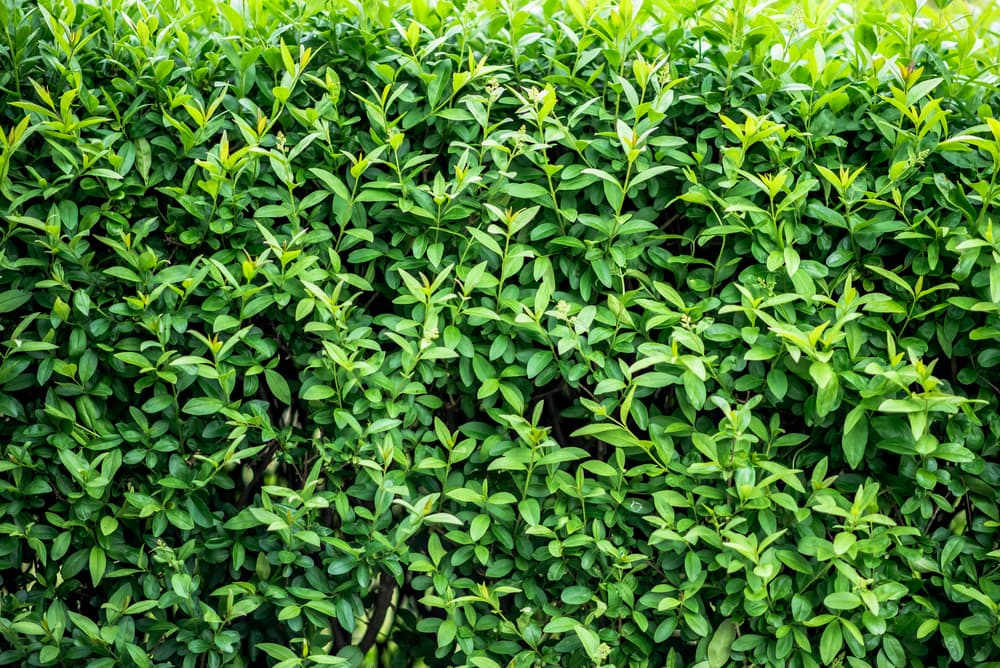
- BOTANICAL NAME: Ligustrum ovalifolium
- HARDINESS RATING: H4
- ESTIMATED ANNUAL GROWTH RATE: 60cm
- MAXIMUM HEIGHT: 8m
- YEARS TO EVENTUAL HEIGHT: 10-20
If you’re into gardening, the privet hedge may very well be what pops into your head when you hear the word hedge.
This popular variety grows up to 60cm a year, with thick and dense coverage making it great for privacy.
4) Cherry Laurel

- BOTANICAL NAME: Prunus laurocerasus
- HARDINESS RATING: H5
- ESTIMATED ANNUAL GROWTH RATE: 60cm
- MAXIMUM HEIGHT: 8m
- YEARS TO EVENTUAL HEIGHT: 20-50
The Cherry Laurel, also called Common or English Laurel, is another popular choice that can grow around 60cm per year in average conditions.
This is the fastest-growing non-conifer hedge, so bear that in mind if you have an aversion to conifers.
5) Umbrella Bamboo

- BOTANICAL NAME: Fargesia murielae
- HARDINESS RATING: H5
- ESTIMATED ANNUAL GROWTH RATE: 50cm
- MAXIMUM HEIGHT: 4m
- YEARS TO EVENTUAL HEIGHT: 5-10
Bamboo is another option and represents something a bit more exotic.
It is renowned for being fast-growing, with one species recording a growth of 91cm per day.1Fastest growing plant. (n.d.-b). Guinness World Records. Retrieved March 15, 2023, from https://www.guinnessworldrecords.com/world-records/fastest-growing-plant/
Don’t worry though: the type of bamboo used for hedging will grow closer to 40cm per year.
6) Blackthorn
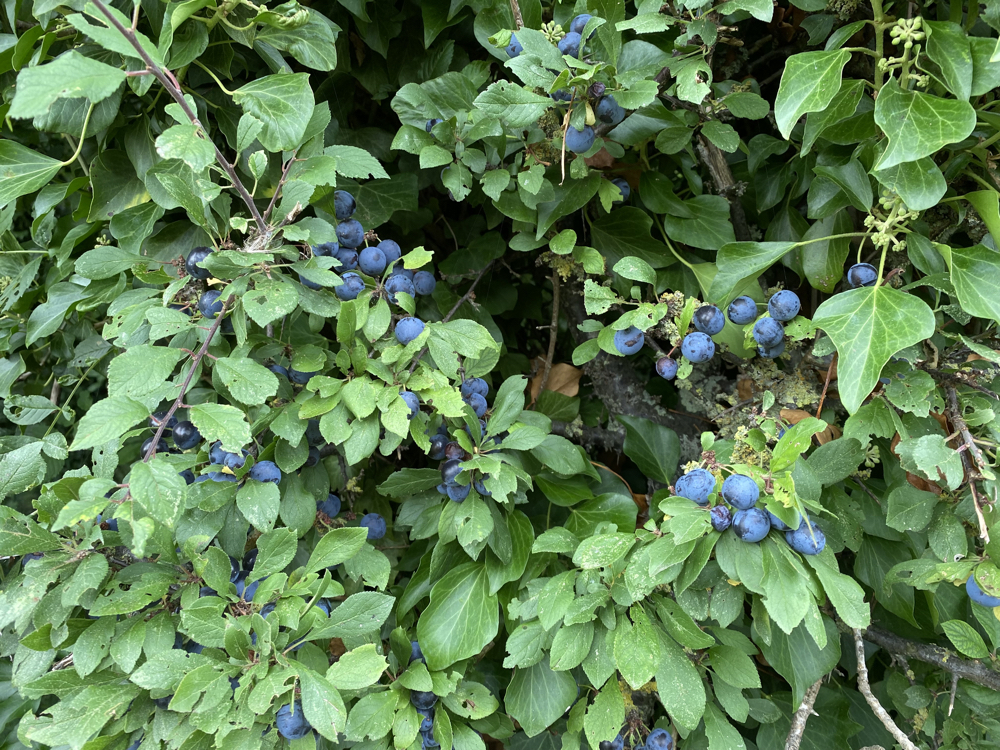
- BOTANICAL NAME: Prunus spinosa
- HARDINESS RATING: H7
- ESTIMATED ANNUAL GROWTH RATE: 50cm
- MAXIMUM HEIGHT: 4m
- YEARS TO EVENTUAL HEIGHT: 20-50
Blackthorn, a deciduous tree, grows up to 4m with a similar spread and makes a great shrub for garden privacy.
It also bears white flowers in the spring and can produce fruits in the autumn.
” As well as being quick growing, Prunus spinosa is a brilliant early flowerer for pollinators,” adds Colin.
“It is also very spiny, so a good security screen if that’s what you’re looking for.”
This thorny tree can become slightly invasive and might require some pruning if you want to keep your hedges in check.
7) Common Hawthorn

- BOTANICAL NAME: Crataegus monogyna
- HARDINESS RATING: H7
- ESTIMATED ANNUAL GROWTH RATE: 45.72cm
- MAXIMUM HEIGHT: 8m
- YEARS TO EVENTUAL HEIGHT: 20-50
The common hawthorn produces cream flowers and red fruits and can grow in most conditions, making it a delight to have in your garden.
This thorny, deciduous tree can grow up to 8m in height and spread and can provide great coverage for the borders of your property.
8) Dog Rose
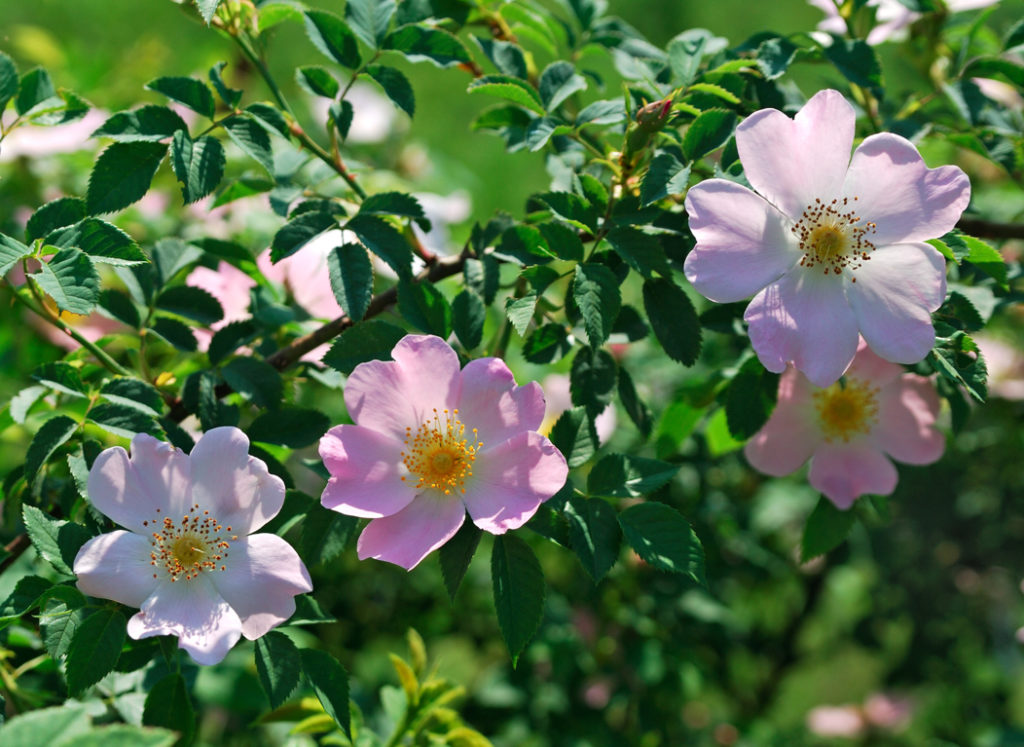
- BOTANICAL NAME: Rosa canina
- HARDINESS RATING: H7
- ESTIMATED ANNUAL GROWTH RATE: 45cm
- MAXIMUM HEIGHT: 4m
- YEARS TO EVENTUAL HEIGHT: 5-10
A deciduous shrub, Dog Rose is fast-growing and can reach up to 4m in height with an annual growth rate of around 45cm.
It’s beautiful pink and white flowers that bloom in the summer make this shrub a lovely attraction as well as a good hedge for privacy.
9) Common Alder
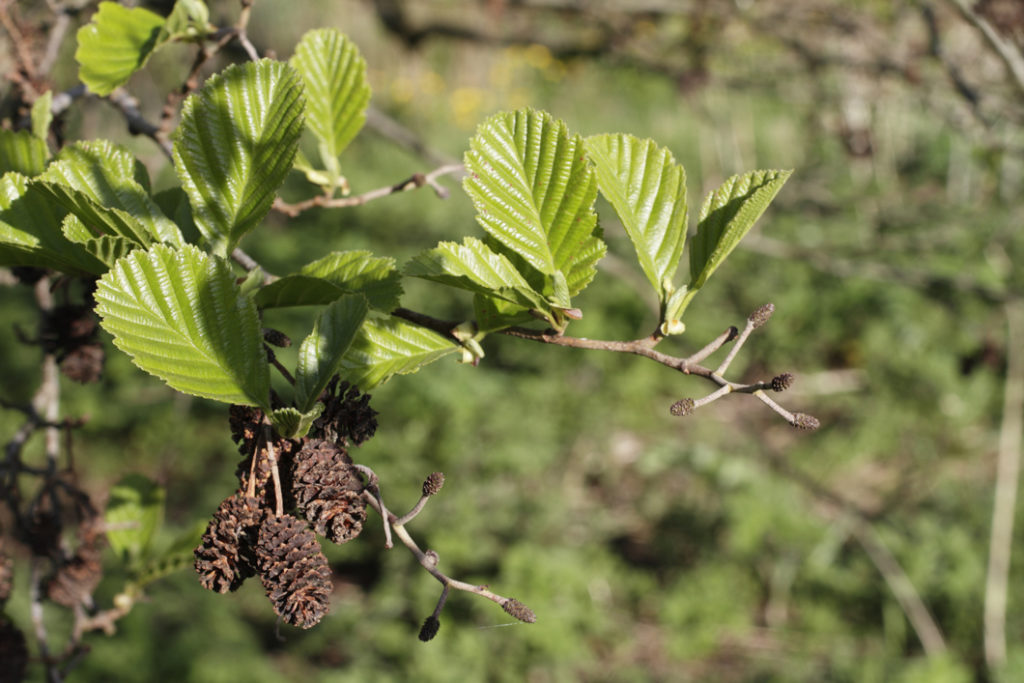
- BOTANICAL NAME: Alnus glutinosa
- HARDINESS RATING: H7
- ESTIMATED ANNUAL GROWTH RATE: 45cm
- MAXIMUM HEIGHT: 25m
- YEARS TO EVENTUAL HEIGHT: 20-50
Common alder can grow up to a massive height of 25m with a spread of up to 8m, making it a great choice for garden privacy.
Unusual brown flowers and fruits bloom in spring and autumn respectively.
Bear in mind that this shrub needs to be grown in full sun, so will need a suitable location in your garden in order to grow at a fast rate.
10) Common Hornbeam

- BOTANICAL NAME: Carpinus betulus
- HARDINESS RATING: H7
- ESTIMATED ANNUAL GROWTH RATE: 40cm
- MAXIMUM HEIGHT: 6m
- YEARS TO EVENTUAL HEIGHT: More than 50
Next up is Hornbeam, a type of plant native to the UK that can be used for hedging, whether alone or in combination with other plants.
The latter option is a great way to create a more informal hedge, as opposed to the neatly trimmed aesthetic that many on the list will bring.
Plants like blackthorn, hazel, and hawthorn make good partners for hornbeam.
Native plants are likely to attract wildlife into your garden, making Hornbeam a great choice to consider.
11) Christmas Berry ‘Red Robin’

- BOTANICAL NAME: Photinia × fraseri ‘Red Robin’
- HARDINESS RATING: H5
- ESTIMATED ANNUAL GROWTH RATE: 30cm
- MAXIMUM HEIGHT: 4m
- YEARS TO EVENTUAL HEIGHT: 10-20
This evergreen shrub grows up to 4m, and although it is one of the slowest-growing hedging plants on this list, it is interesting green and red foliage make it worth the wait.
This shrub can grow in most soils and locations in the garden and produces little white flowers in the spring.
12) White Cedar ‘Smaragd’

- BOTANICAL NAME: Thuja occidentalis Emerald
- HARDINESS RATING: H7
- ESTIMATED ANNUAL GROWTH RATE: 22.8cm
- MAXIMUM HEIGHT: 3m
- YEARS TO EVENTUAL HEIGHT: 10-20
The Thuja Emerald is another popular choice for gardeners who want hedges with lower maintenance, thanks to its cone shape.
This plant will grow around 30cm a year in good conditions, up to a maximum height of around eighteen feet.
Why Grow A Hedge?
A hedge is not a specific type of plant.
The term refers to a collection of bushes and shrubs lined up to provide a barrier.
Hedges can be evergreen or deciduous, or a combination, thanks to the possibility of combining plants in a hedge.
They can be formal or informal, with formal hedges being neatly arranged and well-trimmed.

Informal hedges are often just a row of plants left to grow into a barrier: less maintenance will be required, and the overall aesthetic will be more rustic.
Hedges are popular because of the myriad benefits they can bring to your garden.
They can help to mark the outer boundaries of your garden, or to provide structure by marking areas within it.
Their height can offer privacy and shade, and their density means they can also block the wind.
Important Considerations
There are pros and cons to keep in mind when choosing the type of hedge you want in your garden.

These include:
- The density of some hedge species means that as well as providing privacy, they can block noise and even pollution from entering your garden.
- Evergreen hedges are in bloom all year round and can provide privacy and shelter the whole time, but will require more maintenance as a result.
- Deciduous hedges, on the other hand, will lose their leaves in winter. As a result, less shelter is provided, but there is the benefit of wind filtered rather than blocked: in very strong winds this means the hedge is more sturdy.
- Certain hedges are thorny, which can add a layer of security if you are concerned about privacy.
Choosing the right hedge, therefore, comes down to the purpose you want it to serve.
If you are using a tall hedge for privacy purposes, be aware of these criteria.

When it comes to your garden, it’s probably not worth getting involved in legal disputes with the neighbours.
The best way to avoid this? Talk to your neighbour in advance.
Letting them know that you’re planning to grow a tall hedge, and asking their thoughts, is a great way to prevent conflict later on.
Looking After Hedges
You’ll first want to make sure that the hedge you choose is suitable for the growing conditions in your garden.
Think about soil conditions, light levels, and acidity levels.
Then you’ll want to ensure that you plant at the right time of year.
From autumn to early spring is best, offering the lowest likelihood of the hedge’s roots drying out.

Check there are no weeds in the weeks coming up to planting, in order to give the hedge the best chance of taking root.
Deciding the age of the hedge you plant is important too.
Roots are younger and will take longer to get going, whereas planting out from a pot will set things in motion more quickly.

It all depends on what your end goal is: if it’s privacy, you’ll probably want to choose the quicker option.
Also, keep in mind that a faster-growing hedge will require more maintenance.
Once your hedge is up to the desired height, you’ll be trimming off new growth.
More growth means more trimming and more work.
That’s All Folks!
Whatever your reasons for wanting a fast-growing hedge – whether it be privacy, shade, shelter, or just aesthetic – you have plenty of options.
From deciduous to evergreen, and from formal to informal, you will be able to find a hedge that perfectly matches your needs and preferences.

Hopefully, after reading this guide, you’re equipped with the knowledge you need to choose the right hedge for your garden.
References
- 1Fastest growing plant. (n.d.-b). Guinness World Records. Retrieved March 15, 2023, from https://www.guinnessworldrecords.com/world-records/fastest-growing-plant/

